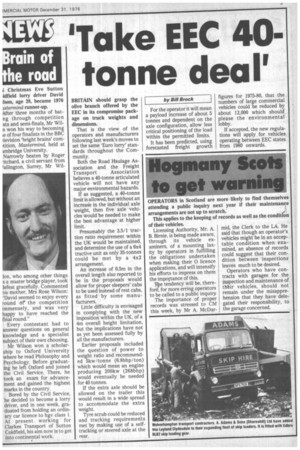'Take EEC 40 tonne deal'
Page 5

If you've noticed an error in this article please click here to report it so we can fix it.
BRITAIN should grasp the olive branch offered by the EEC in its compromise package on truck weights and dimensions.
That is the view of the operators and manufacturers following last week's moves to set the same 'Euro lorry' standards throughout the Community.
Both the Road Haulage Association and the Freight Transport Association believes a 40-tonne articulated vehicle will not have any major environmental hazards.
If as suggested, a 40-tonne limit is allowed, but without an increase in the individual axle weight, then five axle vehicles would be needed to make the best advantage at higher limit.
Presumably the 3.5/1 traction ratio requirement within the UK would be maintained, and determine the use of a 6x4 tractive unit as only 35-tonnes could be met by a 4x2 arrangement.
An increase of 0.5m in the overall length also reported to be in the proposals would allow for proper sleepers' cabs to be used instead of rest cabs, as fitted by some manufacturers.
Little difficulty is envisaged in complying with the new imposition within the UK, of a 4m overall height limitation, but the implications have not as yet been assessed fully by all the manufacturers.
Earlier proposals included the question of power to weight ratio and recommend ed 5kw /tonne (6.8bhp/ton) which would mean an engine producing 200kw (268bhp) would eventually be needed for 40 tonnes.
If the extra axle should be allowed on the trailer this would result in a wide spread to accommodate the extra weight.
Tyre scrub could be reduced and tracking requirements met by making use of a selftracking or steered axle at the rear. For the operator it will mean a payload increase of about 5 tonnes and dependent on the axle configuration, allow less critical positioning of the load within the permitted limits.
It has been predicted, using forecasted freight growth figures for 1975-80, that the numbers of large commercial vehicles could be reduced by about 12,000 which should please the environmental lobby.
If accepted, the new regulations will apply for vehicles operating between EEC states from 1980 onwards.




























































